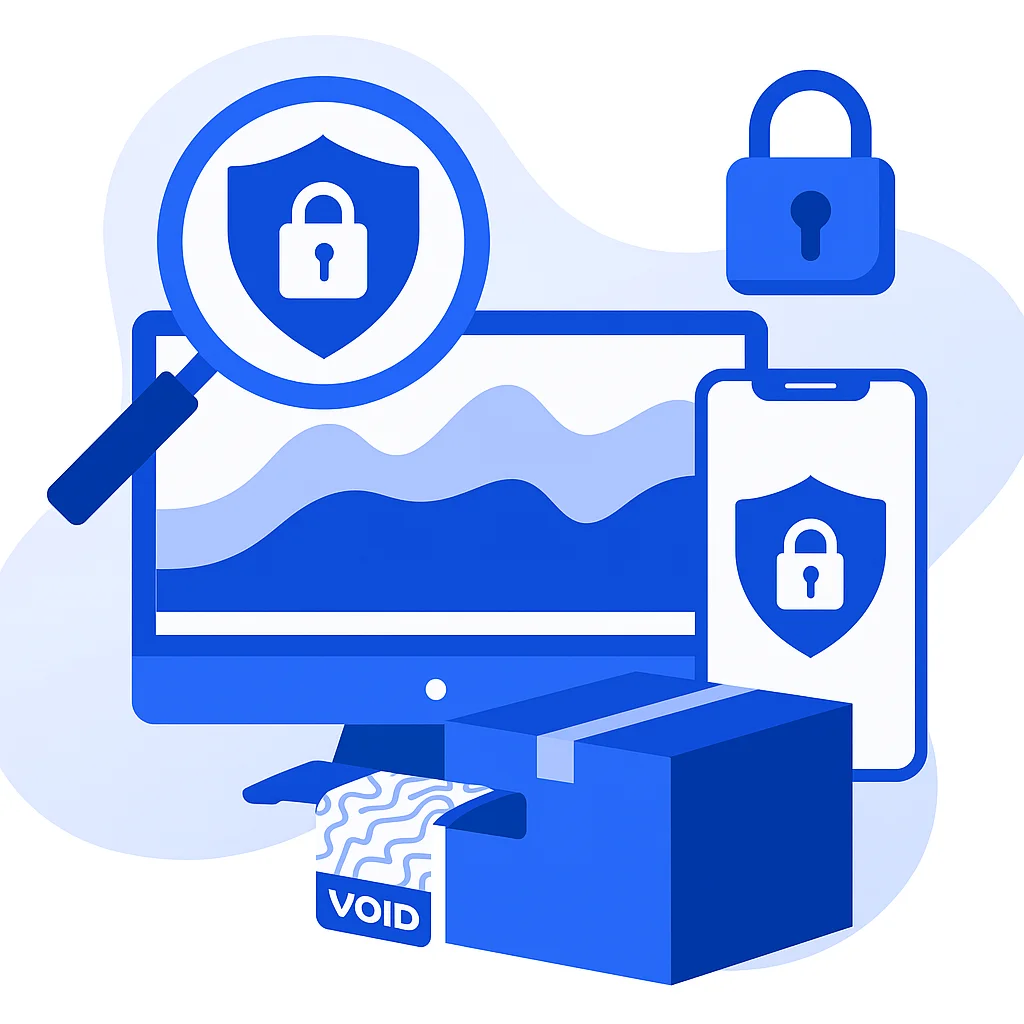In today’s hyper-connected world, online brand protection is not just important, it’s essential. As companies increasingly operate in digital environments, threats to brand identity, reputation, and revenue continue to grow. From counterfeit products sold on e-commerce platforms to unauthorized social media accounts and phishing websites, malicious actors have become more sophisticated than ever. For counterfeit detection, businesses must use equally advanced strategies to preserve customer trust and brand equity.
At HeyTony, we are committed to helping you navigate the complex landscape of digital brand protection. We understand a successful strategy requires an integrated approach, so we’ve curated this practical guide. It’s designed to help you implement four proven tactics to safeguard your brand for defense and growth in a secure, trust-centered environment. With the right tools and expert support, brand protection can become a competitive advantage instead of just a cost center.
1. Monitor and Enforce Your Intellectual Property (IP) Online
Protecting your brand starts with knowing where and how it’s being misused. Proactive monitoring helps you identify unauthorized use of trademarks, brand names, and assets before they spiral into larger threats. Once a violation is detected, swift legal enforcement ensures that counterfeiters and infringers are held accountable. A strong IP enforcement strategy helps maintain your brand’s integrity and avoid long-term reputational harm.
Why Trademark Monitoring Is Foundational
The first step in a strong digital brand protection strategy is continuously monitoring your intellectual property. This includes tracking trademarks, logos, brand names, and product visuals across search engines, online marketplaces, and social platforms. Early detection of infringement helps minimize damage and allows companies to act before the problem escalates.
Tools That Make IP Monitoring Easier
Advanced digital brand protection software offers AI-powered scanning across the internet, including deep and dark web environments. These digital brand protection tools automatically flag unauthorized listings, impersonation attempts, and domain infringements. Some also automate takedown notices and generate legal documentation, enabling swift enforcement.
Legal Brand Enforcement Is a Must
Trademark monitoring is just the beginning; you must also enforce your rights. Work with legal counsel to issue cease-and-desist letters, file complaints with hosting providers, or escalate to litigation if needed. Failure to enforce IP rights can lead to brand dilution, reputational harm, and even regulatory penalties.
2. Invest in Threat Intelligence Platforms for Online Brand Protection

As cyber threats become more advanced, traditional monitoring tools are no longer enough. Threat intelligence platforms offer a proactive, real-time view of how and where your brand is targeted across digital environments. These tools give you the power to detect phishing attacks, impersonation attempts, and fraudulent activity before it impacts your customers. Investing in these platforms can save your business from major financial and reputational setbacks.
Understanding the Scope of Digital Threats
Online threats have evolved far beyond fake products. Today, brands face phishing scams, account impersonation, malware distribution, and misinformation campaigns. Platforms like ZeroFOX, Doppel, and Bolster are designed to proactively identify these threats and support mitigation efforts before they affect consumers. These digital brand protection tools help safeguard brand reputation, customer trust, and digital assets across web, social media, and dark web channels.
What Threat Intelligence Tools Offer
Threat intelligence platforms provide real-time insights across digital channels. They aggregate signals from web activity, social platforms, and known malicious networks to detect threat patterns. This data-driven approach helps prioritize action, uncover bad actors, and support legal or compliance teams with actionable intelligence. By turning vast amounts of threat data into clear insights, these platforms enable faster, more thoughtful decision-making to prevent reputational and financial damage.
3. Track Product Authenticity with Secure Digital IDs

Counterfeits hurt revenue, erode customer confidence, and damage long-term brand value. Secure digital IDs, like QR codes and serial numbers, help you verify the authenticity of every product at every stage of the supply chain. These tools enable better fraud detection and improve visibility and accountability in your logistics operations. As digital trust becomes a competitive advantage, authentication tech is no longer a nice-to-have; it’s a must.
Track-and-Trace Technology: A Game-Changer for Brand Protection
Product authentication is a crucial part of all comprehensive online brand protection services. Expert systems like Authentix’s DigiTrax allow businesses to assign encrypted QR codes or serialized IDs to each product. This enables end-to-end tracking of an item’s lifecycle, from manufacturing to the customer’s hands. It also instantly empowers consumers to verify authenticity, helping deter counterfeiters and build long-term brand loyalty.
How It Works
Using a smartphone, consumers and inspectors can scan DigiTrax codes to verify authenticity and review logistics data. These tools detect grey market activity, product diversion, or other signs of tampering. The platform provides real-time feedback that helps companies make smarter supply chain decisions. This level of visibility strengthens brand protection and enhances operational efficiency and trust across global distribution networks.
Beyond Security: Engaging the Consumer
Digital IDs also serve as customer engagement touchpoints. Brands can offer post-sale content, warranty verification, and rewards programs through a single scan. This builds trust and keeps your brand top-of-mind long after purchase. It also provides valuable insights into consumer behavior, enabling brands to personalize marketing and optimize future campaigns.
4. Use Multi-Layered Digital Security

No single defense mechanism is foolproof, especially when threats come from so many directions. A multi-layered approach combines different technologies to create a more resilient security posture. Integrating digital protection layers into your brand’s online platforms makes it significantly harder for counterfeiters to replicate or bypass your defenses. This layered model ensures both broad deterrence and deep traceability.
Why a Multi-Layered Brand Protection Strategy Matters
As threats evolve, so must your defenses. A multi-layered digital security strategy deters counterfeiters and provides visibility into emerging risks, enabling faster incident response. From tamper-proof packaging to AI-driven detection, these layers work in tandem to protect every digital touchpoint and reinforce consumer trust.
Digital Security Layers
- IP Monitoring: Automated tracking of trademarks, logos, and product visuals across search engines, e-commerce, and social media.
- Threat Intelligence: Real-time detection of phishing sites, impersonation, and unauthorized online activity through AI-driven analytics.
- Online Takedown Support: Automated issuing of takedown notices and brand enforcement against counterfeit listings and infringing content.
- Track-and-Trace Integration: Encrypted QR codes and digital identifiers are used for real-time product authentication.
- Consumer Engagement Tools: Branded verification apps and portals that allow customers to confirm product authenticity.
- Forensic Digital Trails: Metadata and server log capture for evidence-based legal action and chain-of-custody verification.
The Role of Professional Services in Online Brand Protection
Here’s a quick comparison of the top online brand protection software in 2025, focusing on features, ideal users, and standout capabilities:
| Platform | Best For | Key Features | Standout Advantage |
| Red Points | E-commerce & DTC brands | IP monitoring, counterfeit detection and removal, domain protection, and marketplace enforcement | AI-driven detection with real-time takedowns across 30+ platforms |
| BrandShield | Enterprises & public companies | Social media protection, phishing detection, and impersonation monitoring | Combines cybersecurity with brand protection in one dashboard |
| Incopro (Corsearch) | Multinational corporations | Legal enforcement, data clustering, and global brand intelligence | Deep analytics and collaboration tools with IP teams and counsel |
| ZeroFox | Cybersecurity & risk-focused firms | Social media monitoring, phishing mitigation, and dark web scans | Strong focus on digital risk protection and executive impersonation |
| MarkMonitor | Fortune 500 & high-value brands | Domain management, trademark enforcement, fraud detection | Enterprise-grade protection with ICANN-accredited domain expertise |
| AppDetex | Mobile-first brands & app developers | App store monitoring, rogue app takedown, and domain threat detection | Specializes in app and mobile ecosystem brand protection |
The Time to Act is Now
Online brand protection services are not a one-time fix; it’s an ongoing process that must adapt to emerging threats. In 2025, digital-first criminals are evolving fast, and so must your brand defense strategy. By implementing the four tactics outlined in this post, businesses can deter counterfeiters, protect customer trust, and reinforce long-term brand value. A sustained, multi-layered approach ensures your brand remains resilient in a rapidly changing digital landscape.
Explore the HeyTony blog for the latest strategies on digital marketing, SEO, and brand protection to help your business grow smarter, faster, and safer.
Originally published . Last updated .
Categories:
Explore More

